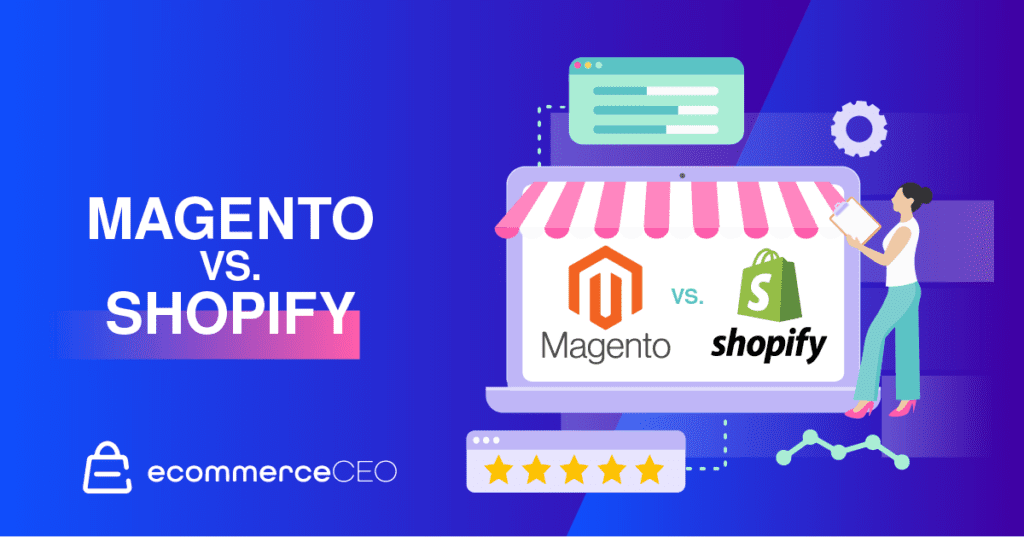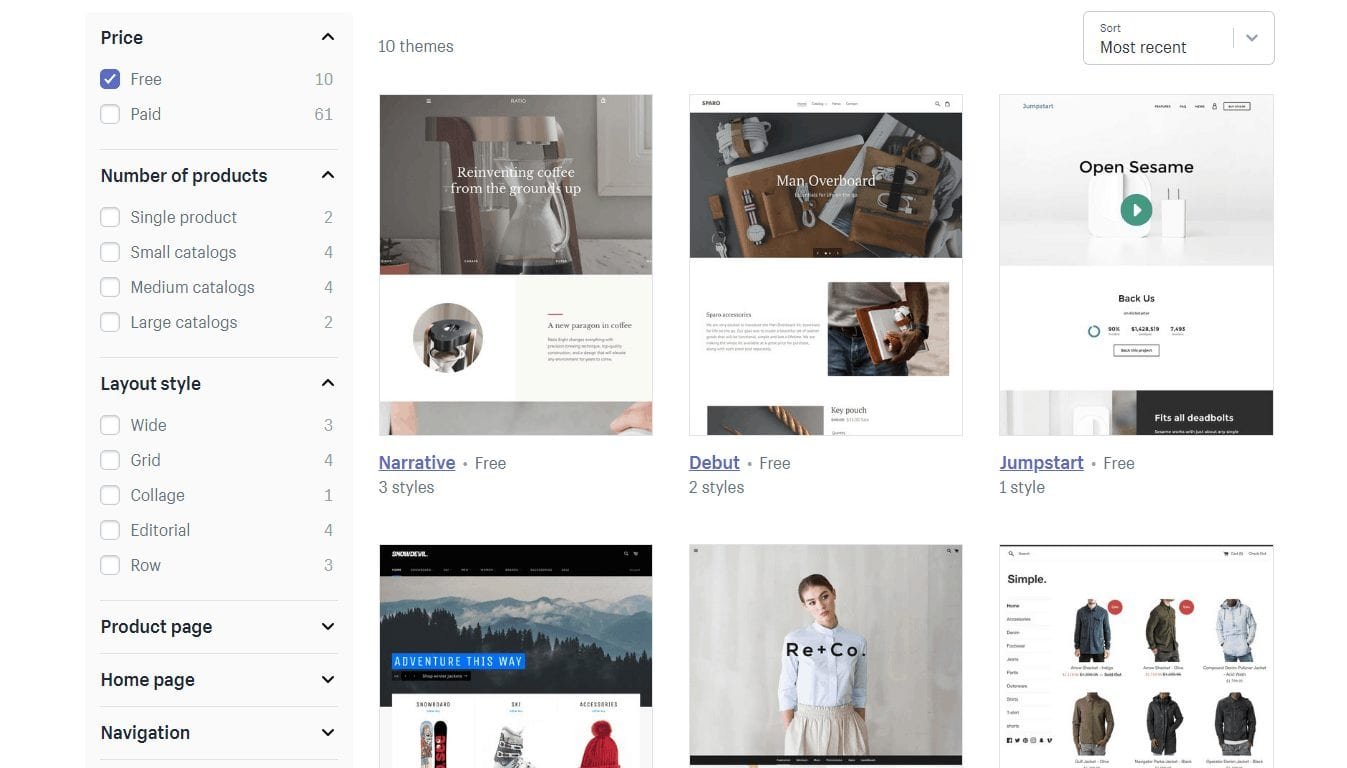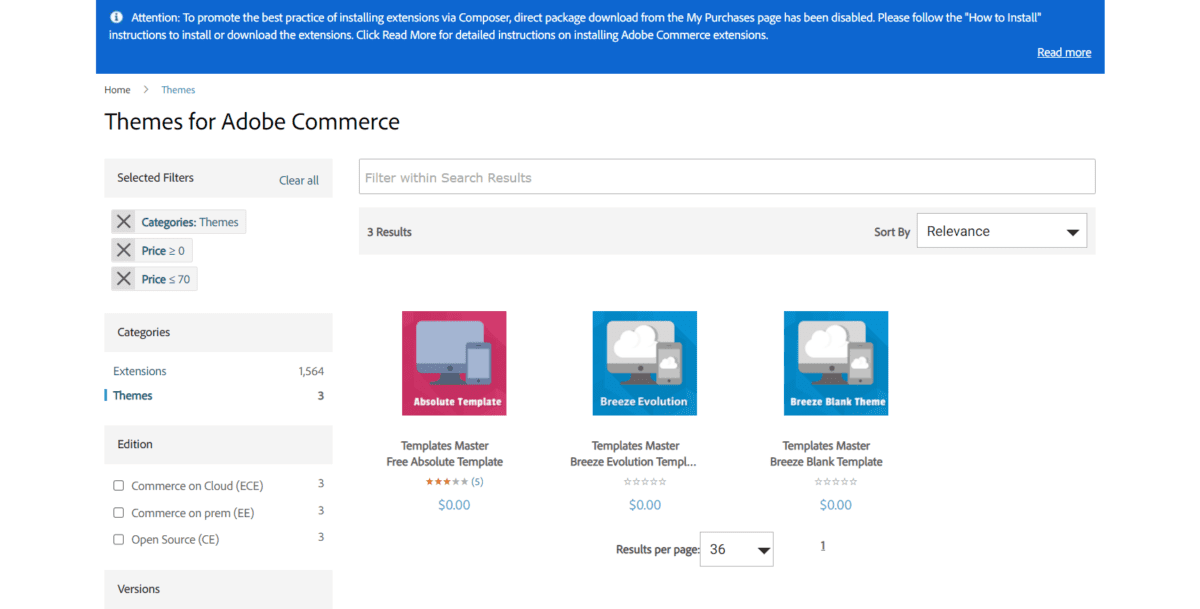Adobe Commerce (formerly Magento) vs Shopify is a common battle. Both are two big players in ecommerce. Their models, pricing, and programming language are very different.
When starting an ecommerce between, it’s important to choose the right one. Choosing the wrong platform only to scale back a few weeks later is a nightmare; time and money wasted. I’ve been there, and trust me:
No one wants that.

So, I compared Shopify vs Adobe Commerce to get down to the essentials and help you pick out the one for your online store.
Shopify
Shopify is a hosted ecommerce platform. You wouldn’t be dealing with the cost of hosting and the technicalities. It’s great at online stores, especially drop shipping and for small stores relying on social media marketing. I’ve used it before, and I have worked with clients who have stores on Shopify.
Beginners will find Shopify easy to use. The dashboard is intuitive, store building is easy, and you can drop elements to build your store. Give it a weekend or a few hours, and you’re set up. If you own a small business and plan on doing most of the optimization and day-to-day run, Shopify might be better for you.
Pros
- Beginner-friendly and super easy to set up
- Lighting speed load time
- Customer support, available for cheap
- Easy to integrate your store with other platforms like Amazon
Cons
- Rated poorly in SEO
- Unable to customize everything
- Transaction fee, charged per sale
Adobe Commerce
Adobe Commerce is open source. It’s powerful for customizing your store, and you can get a finished product that doesn’t look like every other store out there. There’s no limitation to what you can do – as long as the skill to do it is available.
It’s also a self-hosted ecommerce platform and a popular go-to for big brands.
Adobe Commerce offers great for SEO as well. If you’re selling a few products or you don’t have technical knowledge, stick with Shopify Very few beginners can get into a Adobe Commerce store and get down to working immediately; you’ll need to invest a bit of time in understanding it.
Pros
- Feature rich
- Strong SEO and SEO features
- Built-in 1-click selling
- No design limitation
Cons
- Steep learning curve
- Cost of hosting, extensions, and themes can add up and become costly
- Easily slowed down
- Virtually no support from Adobe Commerce
Ecommerce Platform Hosting Comparison
Hosted and self-hosted platforms work differently. With most hosted ecommerce website builders, you don’t get total control. Sure, many of them, like BigCommerce and Shopify allow you write in CSS and HTML, but for the core programming, you either don’t have access or need one of their developers to get in there for you.
The good thing about them is that they are built to support online retailers. From built-in concentrated features and integrations to customer support. Security and load time is taken care of (mostly) by the platform, and given that they are selling a service for a fee, that is usually taken seriously.
Also, you wouldn’t get to deal with the lack of certainty about how much you’ll spend. For example:
With Shopify, you know for sure that you’ll pay an amount each month/year to use the platform. Then if you’re getting a paid app or theme, that’s year-on-year. So, from the start, you can see how much you’ll spend.
For self-hosted though, it’s a whole different ball game:
The price of hosting, security, and domain registration are separate. Then you’ll have to calculate the cost of developing your online store.
You’ll go into negotiations with uncertainty about how much you’ll spend. When you have gone through all of that, you get to the management process. Adobe Commerce 2 requires beginners to move around and learn a few things before they can confidently change whatever on their site without breaking it.
Then, you have to bother about optimizing your site for speed. Having a website that easily slows down is never a good thing. You can optimize the speed; it will take time (and money if you don’t know how).
Look at my overview of similar self-hosted and hosted shopping cart solutions.
How To Choose An Ecommerce Solution
No ecommerce platform is perfect. While there are extra goodies that you might like on one platform over another, those might not be the major thing you should look out for. Generally, these things are essential for ecommerce entrepreneurs, some more than others:
- load time
- ease of use
- Developer friendliness
- Cost of the initial set up
- Presence of technical support
- Design flexibility and mobile-readiness
- SEO tools
- upselling & cross-selling
- Product options
- Marketing automation
- Robust content management system
To objectively choose, you’ll need to see how these factors work in both platforms. At the end of this article, you’ll be crystal clear when it comes to Adobe Commerce vs Shopify.
Pricing & Value Comparison: Adobe Commerce Vs Shopify
Given the nature of Adobe Commerce and Shopify, it’s not surprising that the pricing structure is different. Before I go into that, I’ll touch a bit on the similarities in the pricing. That’s the special place for really large ecommerce businesses.
So, Adobe Commerce has the enterprise – Adobe ecommerce – and the cloud version – Adobe Commerce Cloud – where you pay about $22k and above for licensing and an extra cost for using the cloud platform, which also covers things like Fastly CDN. Adobe Commerce pricing will vary based on your custom build. But the open source software is free.
And Shopify has Shopify Plus which starts at $2k per month and then increases based on how much you’re making.
However, most people reading this post have either not started their ecommerce business or are at the growth stage of their startup. So, I wouldn’t dwell much on the enterprise versions of both. If you have questions in this regard, you can hit me up in the comments or send me a message.
Now, over to the toned-down versions of Shopify and Adobe Commerce:)
Adobe Commerce

The open source community edition of Adobe Commerce differs from the Adobe Commerce version in features, but most of the extras shouldn’t be much of a difference for startups.
Moving on, the open-source platform doesn’t charge you anything to download and use it. All you have to do is purchase a hosting plan.
Adobe Commerce works better with great hosting. When you don’t have the best, your backend can slow down, and you wouldn’t be able to keep up with orders as they come, that’s if your front end doesn’t go off as well.
When purchasing your hosting, don’t rush for the cheapest plan. Keep an eye out for bandwidth and any extra optimization package. Be wary when you see “unlimited bandwidth.” Check out the terms and conditions, acceptable usage limit, and knowledge base to know the actual limit.
That significantly affects how long your site is up, especially if you’re getting a sizable number of traffic.
Asides from hosting, you’ll need to factor in the cost of getting Adobe Commerce developers. There’re many good ones in the community, but most times, the available ones are costly. You could see one going for $100 per hour.
I’m not trying to scare you from Adobe Commerce or anything. Sure, there are some good ones for less – $20 per hour or so, but having them free to take your project is a big deal. You’ll have to settle down and search.
If you have the money or you were previously a Adobe Commerce developer, then this part shouldn’t be hard.
Then the extensions are another thing. I don’t like that you have to buy an extension for multi-channel sales; Shopify wins this for me. Other things that are not free include dropshipping apps.
Look out for these apps to extend your online store’s functionality:
- Subscription and Recurring Payments by Aheadworks for $299
- SellBrite Multi Channel Automation for $200/month
- AliExpress Dropshipping for $149
Shopify
Shopify pricing structure is different:

For one, it’s self-hosted, so you don’t pay separate fees for hosting. You’ll still buy your domain name. There are three plans that most ecommerce stores can use:
- Basic Shopify
- Shopify
- Advanced Shopify
The basic Shopify plan offers enough for most online stores. You can sell unlimited digital and physical products and sync with Amazon, eBay, and Facebook. The Shopify plan takes it higher by allowing gift cards, retail hardware support, and professional reports. Then on the Advanced Shopify plan, you get all that with third-party real-time shipping rates.
The major issue with Shopify, which Adobe Commerce doesn’t have, is transaction fees. Depending on your plan, you will pay between 2% and 1% on each transaction if you collect credit card or e-wallet payments with third-party payment gateways. Shopify Payments is a solid gateway, but it blocks other things like some up/cross-selling apps.
Let’s also not forget that some apps like ReCharge for selling subscriptions also charge their own transaction fees. That’s eating into your margins already.
Between that and the apps that can add up, you might spend a lot. You might need to check out the Shopify app store to figure out your monthly cost:
- Bold Upsells from $9.99/month
- Cross Sell Recommended Products at $19.99/month
- Subscriptions by ReCharge for $39.99/month
Winner = Shopify
Despite the cost of Shopify apps, it’s still clear that the pricing structure is more favorable, especially for startups. It’s clear from the get-go, and you might not need to pay much to extend your online store’s functionality, unlike Adobe Commerce. Plus, Shopify offers a free trial, so you could try it out first before diving in.
Head To Head Performance Comparison
In terms of overall performance, Shopify does way better than Adobe Commerce. I based this on the load time, speed on both mobile and desktop, and SEO rating.
| Platform | Performance | Load Time | Mobile Speed | Desktop Speed | Avg SEO Traffic |
|---|---|---|---|---|---|
| Shopify | 3.9 | 1.3 | 63 | 75 | 11717 |
| Sellfy | 3.1 | 1.4 | 46.8 | 72 | 134 |
| Zyro | 3.3 | 2.1 | 51 | 89 | 128 |
| Nexcess StoreBuilder | 4.0 | 1.93 | 53 | 72 | 58,645 |
| ShopWired | 4.3 | 1.38 | 56 | 80 | 717 |
| Pixpa | 2.3 | 1.6 | 22.66 | 65.5 | 72 |
| Freewebstore | 3.5 | 1.89 | 53 | 79 | 927 |
| Ecwid | 3.5 | 5.0 | 50 | 82 | 15,517 |
| Square Online | 2.8 | 2.03 | 1.0 | 3.0 | 65,317 |
| BigCommerce | 4.5 | 2.2 | 63 | 80 | 33626 |
| Woocommerce | 3.1 | 3.4 | 42 | 52 | 72968 |
| Shift4Shop | 3.0 | 2.8 | 50 | 58 | 9703 |
| Volusion | 2.9 | 3.5 | 48 | 56 | 15779 |
| Adobe Commerce | 2.8 | 4.8 | 39 | 43 | 19408 |
| Prestashop | 2.9 | 4.62 | 50 | 52 | 33851 |
| SquareSpace | 3.5 | 3.5 | 42 | 63 | 5678 |
| Wix | 3.9 | 3.2 | 69 | 81 | 543 |
| Weebly | 2.6 | 3 | 49 | 59 | 186 |
Load Time
On average, ecommerce store builders load in about 3.2 seconds. From my tests, Shopify sweeps that away, loading in 1.3 seconds. If you’re to use Shopify, you should have no worries about how fast your website loads.
Adobe Commerce isn’t that much of a good player. While its load time isn’t all that terrible, it doesn’t meet the average. The average load time of the Adobe Commerce stores that I tested came in at 4.8 seconds.
I did mention earlier that most of the optimization for Adobe Commerce is done by you, so you can improve that. Just be ready to know how or pay a developer to help you.
SEO
Adobe Commerce is more powerful, but Shopify is easier to manipulate for the average user. I’ll explain:
Adobe Commerce adds .html to the end of product and category URLs. While this doesn’t have a major effect on SEO, it might add length to your URL and make it less user friendly to read.
You can take that out in the Admin Panel. That’s the easy one.
Then, there’s the /index.php/ string. So, your product URL ends up looking like:
https://examplestore.com/index.php/example-product/
To remove that, you’ll need to know how to edit your .htaccess file. If you go in there and touch something else, you might break your site. So, developer help is needed here again. But it’s still better than the rigid URL structure of Shopify product pages.
On Shopify, if you go through collections to get to the product, you get two strings added to the URL:
/collections/ and /products/.
If you go through a search engine, then you have /products/ only. Having /collections/ is not bad for a big store with many categories, but if you sell a few products, having that makes no sense.
Also, the /products/ string should be flexible to allow people to keep it or not. That’s not a nice one.
Asides from the URL, both Shopify and Adobe Commerce are on par with other product SEO nitty-gritty. You can easily edit your title and meta description from your dashboard, and also use the canonical tag.
On Adobe Commerce, you can create a sitemap directory to generate sitemap.xml, and on Shopify, it’s automatically generated.
Blogging
Asides from ads, one thing that can draw in massive traffic is blogging. Writing high-quality content around your product and target market can convert customers and build trust.
Shopify has a built-in blog. If you want to take it further, you can use apps like Shogun Page Builder to build templates for user-friendly long-form posts.
On Adobe Commerce, it’s not that easy. You’ll need an extension to get a blog. There are many of them for this. Aheadworks have one, or you can also install a WordPress module.
PageSpeed
Just like load time, Google PageSpeed is a critical factor that you need to consider before you choose either of these ecommerce platforms.
Shopify is fast on both desktop and mobile, but Adobe Commerceis very slow – it fell way below my average, scoring a 39/100 on mobile. That’s not good enough.
Fortunately, the marketplace has tools that scan speed so that you can pinpoint where you’re lacking.
Winner = Shopify
Shopify has an edge here due to the load time and speed, but those are things you can optimize on Adobe Commerce. You have more advantages with SEO tools and flexibility on Adobe Commerce.
Compare The Features Of Adobe Commerce And Shopify
Adobe Commerce has more features than Shopify. That’s not surprising given that it is built for robust ecommerce over the simplicity that Shopify is bringing in.
One major thing for me is 1-click upsells. Adobe Commerce offers a post-purchase one-click upsell extension, which you can use to do this. There are other extensions in the marketplace which you can try as well.
The only built-in feature that comes close to this is Adobe Commerce Instant Purchase, but it’s not a 1-click upsell. More like a one-click purchase whenever. So, you could stick with that if you don’t want to spend extra.
On Shopify, you need an app to bring in the 1-click upsell functionality.
Adobe Commerce tops Shopify in some areas, though. Offering personalized products, advanced site search, real-time shipping, and up/cross-selling are all built-in features, unlike the latter, where you have to pay for it.
Look at Adobe Commerce‘s detailed features:
Adobe Commerce Features and Plans
Shopify has its good sides as well. To sell digital products, you’ll need an app. Most of them are free, so no issues here.
Abandoned shopping cart email is built-in, and you can offer reward points with a paid app. On Adobe Commerce, you’ll need a paid app to recover abandoned carts, but you can’t use reward points.
See more details:
Shopify Features and Plans
However, both platforms lack in selling subscriptions. You’ll need a paid app.
Winner = Adobe Commerce
Adobe Commerce wins it here. There are more built-in features. You’ll pay for only a few of the essential ecommerce features.
Adobe Commerce vs Shopify: Integrations
If you have a shop outside your website, Amazon, for example, you might want to automate your inventory and orders. Also, if you’re dropshipping, syncing with your suppliers is important.
Some other integrations might matter to you, depending on your business model and operations.
Compare integrations on both ecommerce platforms.
Adobe Commerce’s Integrations
Adobe Commerce falls behind Shopify in terms of integrations plus most integrations need manual installation. You’ll need tech assistance for that.
That said, you can sync with Facebook and Google product data feed and analytics, but that’s about the free integration you get.
If you have an Amazon store, you’ll have to invest in a paid extension to sync both storefronts together. Same thing with eBay.
If you want to do dropshipping, you’re better off sticking with Shopify. That’s because AliExpress Dropshipping and any other Dropshipping app you need is not free.
Customer reviews put people-proof to your products. Hardly ever does anyone buy a product without a review, especially when it isn’t from Apple and those top brands. You can integrate a email marketing automation software like Drip or MailChimp with a free extension.
You can’t integrate Google Customer Reviews for feedback except if you have extra money to pay.
To be crystal clear – with Magneto you can pretty much integrate with everything, but you will need a developer.
Out of the box, it doesn’t do too much:
Adobe Commerce Integrations and Plans
Shopify
Built-in integration for syncing your Amazon and eBay store? Check. Social media and Google. Check.
Do you fulfill orders using Amazon? Then you’ll enjoy the built-in sync that Shopify offers as well.
I like that marketing automation is done free and for dropshippers, it’s easy and free to sync and connect with suppliers.
There are very few things you’ll need to pay for – Alibaba and Google customer reviews are two of those.
Check out the full list:
Shopify Integrations and Plans
Winner = Shopify
Shopify takes this one because of the many free and out-of-the-box integrations it offers. Plus, the others don’t need tech help to fix it. But the upside of Adobe Commerce is much higher.
Design: Compare Shopify And Adobe Commerce
Design on Shopify and Adobe Commerce are entirely different. You’ll find more Shopify themes than Adobe Commerce. Shopify is also much more of a drag-and-drop style website builder.
Check out the number of free themes on the Shopify store:

A good number of nice looking themes. That can save you a lot of money. But then, you look at the Adobe Commerce Marketplace:

Only three free themes. That means the chances you’ll spend on a theme are very high.
With the amount of money you’re already spending on developers, hosting, extensions, and all that. It would have been nice to get more free themes.
If you are using a paid theme, look at the cost. Shopify premium themes costs between $140 – $180. On Adobe Commerce, you’ll get one for as low as $25, but most good ones with modern designs go for way higher than that.
Asides from that, both are excellent with user experience and modern design. In my rating, the average score for modern design is 4.5/5. Both ecommerce platforms scored a complete 5.
Shopify slightly passes Adobe Commerce in Google’s mobile UX score with a 97 over Adobe Commerce’s 96. That’s not much of a difference.
This is the full table:
| Platform | Design & Themes | Visual Design | Mobile UX | Cost Of Premium Themes | # of Free Themes |
|---|---|---|---|---|---|
| Shopify | 4.0 | 5.0 | 97 | $140 | 9 |
| Sellfy | 5.0 | 5 | 93 | $0 | 5 |
| Zyro | 5.0 | 5.0 | 92 | $0 | 50+ |
| Nexcess StoreBuilder | 4.3 | 3.0 | 94 | $20-$100 | 4 |
| ShopWired | 4.3 | 5 | 93 | $3495+ | 20 |
| Pixpa | 4.3 | 5 | 94 | 0 | 131 |
| Freewebstore | 4.3 | 5 | 92 | 0 | 100+ |
| Ecwid | 4.3 | 5.0 | 93 | $60 | 1 |
| Square Online | 3.7 | 5.0 | 92 | $0 | 1 |
| BigCommerce | 3.8 | 5.0 | 94 | $150 | 12 |
| Woocommerce | 4.3 | 3.0 | 97 | $39 | 1000+ |
| Shift4Shop | 4.3 | 4.0 | 95 | $200+ | 50+ |
| Volusion | 3.7 | 4 | 92 | $180 | 18 |
| Adobe Commerce | 3.7 | 5.0 | 5 | $300+ | 1 |
| Prestashop | 3.2 | 4 | 94 | $29+ | 0 |
| SquareSpace | 4.3 | 5.0 | 5 | 100.00% | 14 |
| Wix | 4.7 | 5.0 | 92 | 0 | 72 |
| Weebly | 4.3 | 5 | 97 | $45 | 15 |
Winner = Shopify
I choose Shopify because you have more modern designs for free. If the money doesn’t matter to you, then it’s a tie on everything else.
Head To Head: Ease Of Use
As a shop owner, an easy-to-use platform always helps. Not only for the initial development stage but also for your store’s day-to-day management and growth.
Shopify
Shopify is beginner-friendly and intuitive. Within five minutes of being in your dashboard, beginners can get the grips.
Sure, certain custom settings require a bit of technical knowledge, but you can use Shopify even without that.
Also, you can manage your store without needing technical help. Everything is laid out in the dashboard, from inventory management to marketing and all that.
Another essential thing in ecommerce stores is technical customer support. Regardless of how easy it is to use a platform, you’ll need help at some point.
24/7 support is available, and live operators are there too with phone and chat support.
Adobe Commerce
Adobe Commerceisn’t that nice. If you don’t have the tech help, you will have a hard time setting up your Adobe Commerce store to do anything.
There’s a pretty steep learning curve. You’ll have to take courses (if you absolutely need to do it yourself) and learn the technical terms. That could take you months to get the grips with.
Even if you get a developer to build your store, you’ll need someone or a bit of tech knowledge to manage. The admin panel isn’t so intuitive.
It takes time, and constant use before a beginner can be comfortable.
The good thing, though is that there are extensive user guides, certified partners, and a community that can help you maneuver issues. Beware that there’s no 24/7 phone or chat support.
| Platform | Ease of Use | Phone Support | 24/7 Support | Chat Support | Community Rating | # of Apps/ Plugins |
|---|---|---|---|---|---|---|
| Shopify | 4.9 | Yes | Yes | Yes | 5 | 5,000 |
| Sellfy | 3.5 | No | Yes | No | 4 | 4 |
| Zyro | 3.7 | No | Yes | Yes | 4.7 | 30 |
| Nexcess StoreBuilder | 4.5 | Yes | Yes | Yes | 3.6 | 50,000+ |
| ShopWired | 4.5 | No | No | Yes | 4.9 | 72 |
| Pixpa | 3.7 | Yes | No | Yes | 4.7 | 103 |
| Freewebstore | 3.4 | No | No | Yes | None | 25+ |
| Ecwid | 3.6 | 5.0 | 1.0 | 5.0 | 4.7 | 100+ |
| Square Online | 4.0 | 5.0 | 1.0 | 5.0 | 4.2 | 25+ |
| BigCommerce | 4.8 | Yes | Yes | Yes | 4.0 | 1000 |
| Woocommerce | 3.3 | No | No | Yes | 4.0 | 250+ |
| Shift4Shop | 4.3 | Yes | Yes | Yes | 3.0 | ~250 |
| Volusion | 4.1 | Yes | Yes | Yes | 2 | ~20 |
| Adobe Commerce | 2.2 | No | No | No | 4 | 3000+ |
| Prestashop | 2.9 | Yes | No | No | 3 | 3000+ |
| SquareSpace | 3.8 | No | Yes | Yes | 3.0 | 10+ |
| Wix | 4.2 | Yes | Yes | No | 4.5 | 700 |
| Weebly | 3.6 | Yes | No | Yes | 2 | ~350 |
Winner = Shopify
Shopify won here because the average beginner can set up a store and manage it easily compared to the technical skill required for Adobe Commerce.
Compare Adobe Commerce vs Shopify
No ecommerce platform is the absolute best for every ecommerce business model. It all depends on the size of your store, what you’re selling and what model you’re using. Adobe Commerce is great, so is Shopify. My major issue with the former is that they’ve often released updates filled with bugs, leaving users scrambling to fix their site.
For a precise conclusion on their strengths:
Why Choose Adobe Commerce Over Shopify
If you want to run a large store, you have lots of orders and are earning millions of dollars, Adobe Commerce is better for you. If you don’t mind tinkering or have technical knowledge, you can also choose Adobe Commerce. For a free hand over customizations, go with Adobe Commerce.
Why Choose Shopify Over Adobe Commerce
If you run a small store or you want to try out a few products, Shopify is better. For dropshipping and syncing with multiple online store channels, Shopify is better as well. If you’re new to ecommerce or website development, go for Shopify.











